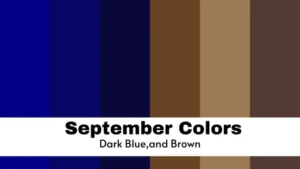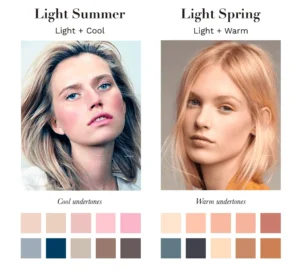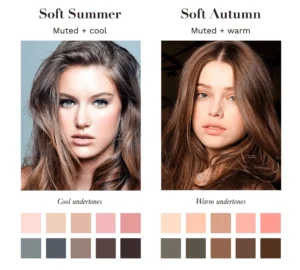Warm (True) Autumn is warm and muted. The warm autumn color palette is just like picturing a walk through an autumn forest: warm, rich, and earthy.
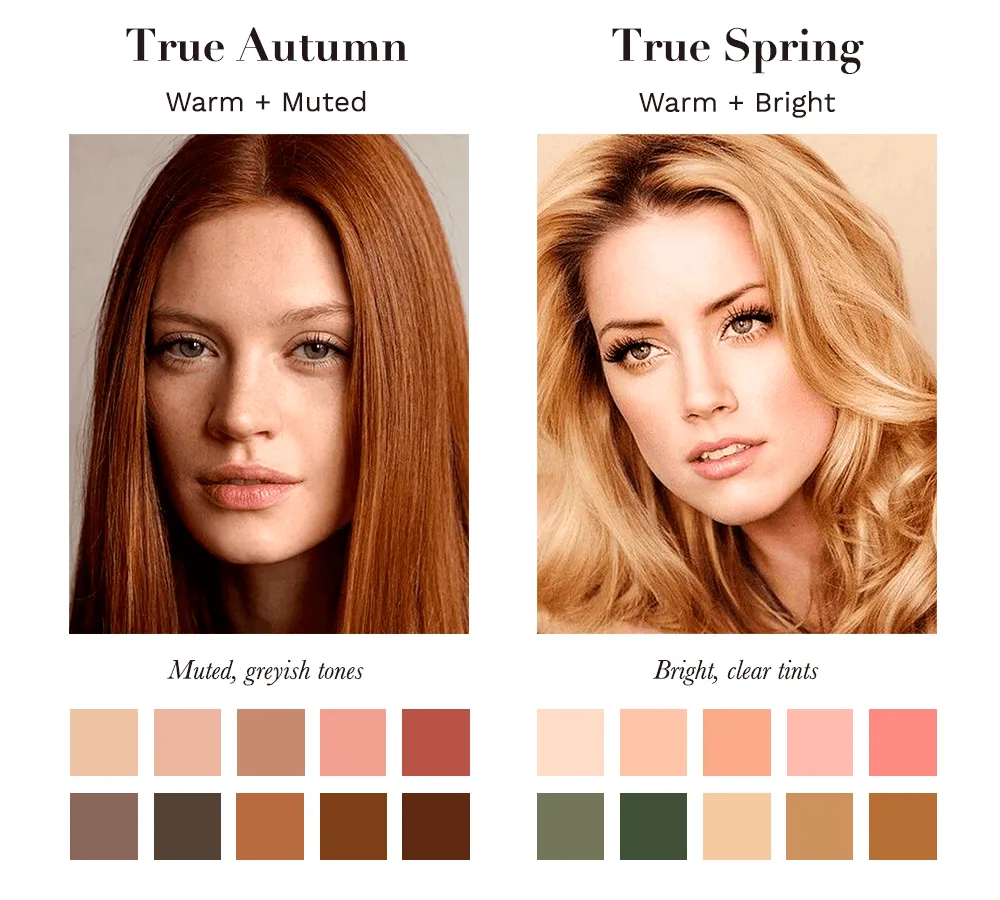
Warm autumn is the original autumn season in the four seasons’ color analysis.
And it also rests between soft autumn and dark autumn on the seasonal flow chart.
True spring is its opposite season, and in contrast to the latter, the appearance of true autumn is rich and muted rather than bright and fresh.
Warm Autumn Characteristics
Skin
The common skin colors include fair with yellow undertones; medium, light brown; tan; light or ivory; and medium brown with golden undertones.
The true autumn skin tone is built on warm undertones. It can have fair to dark skin as long as it has golds and yellows beneath it.
And it is far from the rosy, pink, and olive tones. If this is your season, you are likely used to having skin that gets tanned easily or gets freckles in the sun.
You undoubtedly have a golden goddess glow.
Eyes
The common eye colors for this season include light brown, amber, warm chocolate brown, olive green, golden brown, dark hazel, and medium brown.
In general, autumns possess a peculiar warm color in speckles or starbursts around the pupil and/or on the iris.
Warmth and riches overcome warm autumn eyes. This explains why most people in this sub-season possess eye colors that range from golden brown to dark green.
You should also keep in mind that there are instances where deep blue is mixed with teal.
Hair
The common hair colors for warm autumn include caramel, ginger-copper shades, light, medium, or golden blonde, golden to medium auburn, or golden brown.
Warm autumn hair appears best in coppers, auburns, and gingers, as well as caramels and golden browns.
This is the best way to showcase more of the golden goddess glow. Although determined by the base shade, the golden or rusty undertone will always be present.
Nevertheless, you tend to have extremely distinguishable natural caramel features that add warmth to your look under the sun.
Warm (True) Autumn Color Palette
True autumn colors are warm and rich: mustard, rust, olive, and brown.
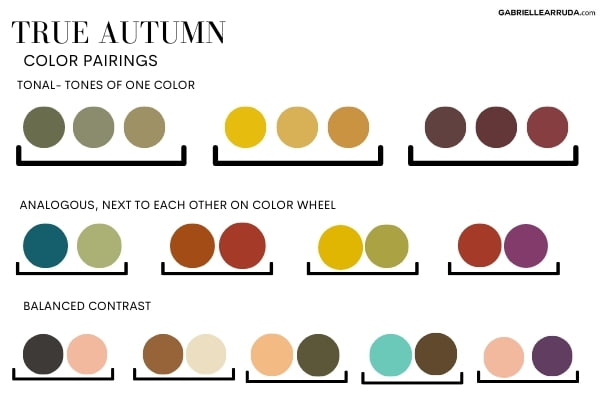
Only when in comparison with a very vibrant season, like spring, is the softness of the colors visible.
The color palette includes shades of corn gold, burnt oranges, ocher, salmon, tobacco, patina, caramel, oxidized copper, plums, and rosemary.
The true autumn palette is warm autumn, with medium-dark, soft, and yellowish colors to complement warm skin.
This season, warm (true autumn), sits at the warmest end of the autumn color palette.
You can wear golden yellows, orange-reds, lots of golden browns, and warm greens.
Color Qualities of a True Autumn
Below are the color qualities of true autumn:
Hue
Hue has to do with the underlying color characteristics of specific colors.
Warm autumns will possess warm hues that have yellow undertones rather than blue undertones.
Value
Value means the ratio of lightness or darkness within a color. Its purpose is to highlight color with regard to how close it is to white or black.
The true autumn value possesses a wide range which contains lighter creams and beiges to dark rich browns.
With that being said, most of the warm autumn palettes cling slightly toward the darker side of the spectrum.
Chroma
Chroma refers to the intensity of the color. This has to do with whether it is soft or muted, or clear or bright.
True autumn clings to the soft or muted side of the spectrum. On the other hand, the colors possess pigment but are not highly saturated or bright.
So, Am I A Warm Autumn?
You have to examine your features correctly for color analysis to be correct.
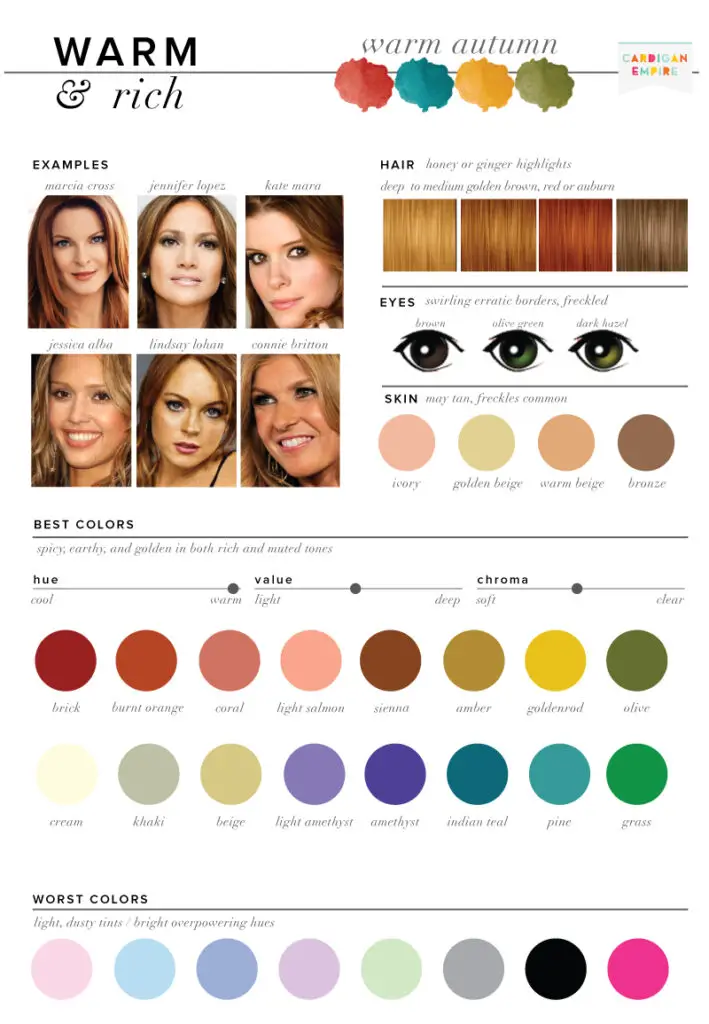
When it comes to your skin, this can be quite tricky, thanks to the fact that your undertone is not easily visible.
That is to say, for an untrained eye, it is hard to detect. Nevertheless, looking at how your skin reacts to certain colors remains an excellent indicator of your natural coloring.
This is something everyone can do. You will notice that vibrant, jewel-like colors like bottle green or hot pink look terrible on you if you are an autumn type.
This is so because the coolness of these colors clashes against the muted warmth of your complexion, which in turn makes you look dull and tired.
For the same reason, light, pastel colors also clash with your look. I will advise that you avoid baby blue and pastel pink.
Well, your muted yet rich color means you look great in dark, earthy colors.
On the other hand, your sister season, warm spring, looks better in vivid, saturated colors and should stay away from these muted colors.
In spite of the fact that they share the same warm undertones, spring and autumn possess extremely different colorings.
And you must avoid mixing them up, as this can lead to disaster in your wardrobe color palette.
This explains why it is so important that you complete a thorough color analysis for correct and flawless results.
Color Combinations
Technically, you can blend any of the colors on the warm autumn palette with each other.
But you need to know that some combinations will turn out much better compared to others.
Those are the combos that repeat the level of contrast that is naturally present in your look.
The natural appearance of true autumn combines, but there is some contrast between the features.
It is also crucial to gain the rich appearance that true autumns naturally possess.
This is to say that the best color combinations for your outfits are those with a lot of color.
Blend colors that resemble each other in hue or value if you intend to gain a lower level of contrast.
Monochromatic combos, which blend different shades of one hue, like light green with a darker green, are complementary.
But, you can even take on more contrast than that as a warm autumn. You are also free to pair neighboring hues with similar values, much like a medium orange with a medium pink.
You also have the option of pairing a darker neutral with a lighter, richer accent color, much like a medium brown with a mustard yellow.
Comparably, you can pair lighter neutrals with richer, darker accent colors. However, you need to know that these combos possess a degree of contrast.
They are not highly contrasting. Stay away from extreme contrast, particularly combos of colors that rest opposite each other on the color wheel, much like blue and orange.
These combos will swallow you up. Neutral-only combos might also look somewhat bland on you.
Conclusion: Warm Autumn Color Palette
The best colors for a warm autumn include golden yellows, deep reds, oysters, coffee browns, every shade of warm green (army green, moss green, forest green), terracotta, and burnt oranges.
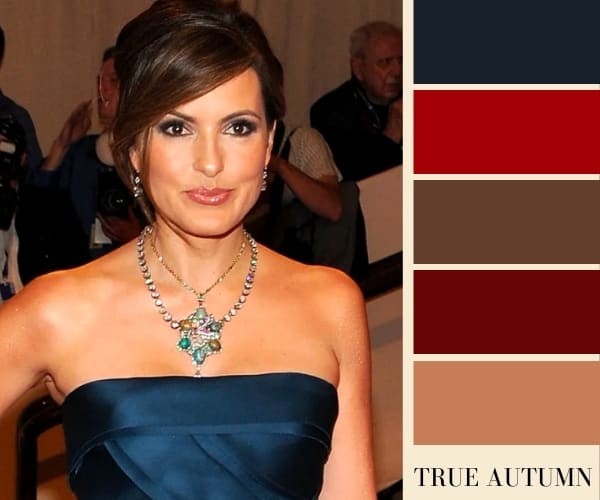
And you might want to know whether autumns can have blue eyes. The truth is that all seasons can possess blue eyes.
However, for autumns, they come in warm blue shades, which include dark teal, deep blue, or turquoise.
Some celebrities that fall under the category of “true or warm autumn” and some coordinating shades and palettes include Isla Fisher, Ana de Armas, Jennifer Lopez, Julianne Moore, Christina Milian, Beyonce, Eva Mendes, Debra Messing, Jane Seymour, and Mariska Hargitay.
So, with all that being said, this concludes this guide on the warm autumn color palette, as you now have detailed information on this season.
